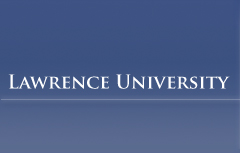Document Type
Press Release
Publication Date
9-22-2003
Abstract
A curious visitor peering through the glass of Room 044 in the basement of Lawrence University’s Science Hall and seeing the large, elevated, aluminum “drum,” its wide sides wrapped with thick, black bundles of wire amid an array of other attached tubes and hoses, might conclude they had just stumbled upon an industrial-strength, high-tech washing machine. Or perhaps a remnant of eccentric “Doc” Brown’s “Back to the Future” workshop.
Far from being a fancy Maytag or a mad scientist movie prop, the contraption is the cornerstone of Lawrence University associate professor of physics Matthew Stoneking’s scientific research. The drum, a “toroidal vacuum chamber” to be exact, which Stoneking brought with him to Lawrence from his research associate days at the University of Wisconsin, is at the heart of his work on pure electron plasmas.
Now, thanks to a three-year, $178,000 grant Stoneking has received from the National Science Foundation, he soon will begin constructing a new and greatly improved apparatus, permitting more sophisticated experimentation. Stoneking’s NSF grant will enable him, in conjunction with Lawrence physics students, to build a less imposing, but much more precisely designed and constructed vacuum chamber out of stainless steel and copper in his new laboratory in the recently renovated Youngchild Hall.
Pure electron plasmas are collections or “clouds” of electrons confined in a vacuum chamber using magnetic and electric fields. Stoneking’s research focuses on the criteria needed for confining a stable electron plasma in a toroidal — donut-shaped — magnetic field and the factors that limit the duration of the confinement in such systems.
A toroidal magnetic field can be visualized as a bundle of lines wrapped into a circular loop, allowing charged particles, such as electrons, to stream or “flow” along those lines like beads on a wire.
Plasma physics is the scientific foundation for the potential future production of electric power by nuclear fusion.
“Although they do not occur in nature, electron plasmas have proved to be excellent systems for testing our understanding of the behavior of ‘complex’ fluids,” said Stoneking. “They can serve as a kind of ‘wind tunnel’ for testing mathematical theories of fluid dynamics.”
In previous experiments, Stoneking successfully confined electron plasmas in a toroidal magnetic field for as long as 2 one-hundredths of a second (or 20 milliseconds). Stoneking estimates the new chamber he will build will improve the purity of the vacuum by approximately 100 times and strengthen the magnetic field by a factor of five, resulting in confinement times approaching one second. Durations of that length would provide a more refined comparison of experimental results with existing theoretical predictions.
The NFS grant will also provide both summer research and travel stipends for Stoneking and his students to attend national physics conferences. In addition, it provides Stoneking with funds to establish a collaboration with physics colleagues at the University of California-San Diego.
This is the third grant Stoneking has received in support of his research since joining the Lawrence physics department in 1997.
“This grant will enable us to extend our understanding of electron plasmas and offer excellent research opportunities for our students,” said Stoneking, who earned his Ph.D. in physics at the University of Wisconsin.
Department
Theatre Arts
Recommended Citation
Lawrence University, "Lawrence University Physicist Awarded $178,000 National Science Foundation Grant" (2003). Press Releases. 253.
https://lux.lawrence.edu/pressreleases/253
